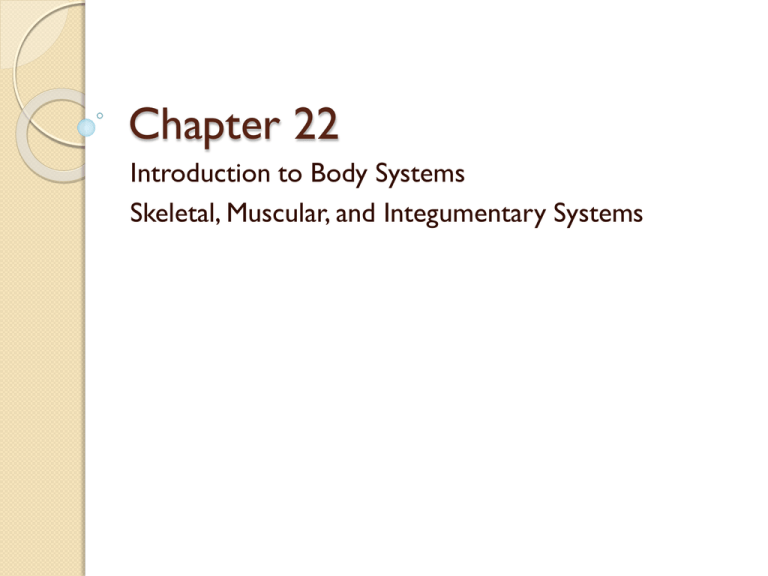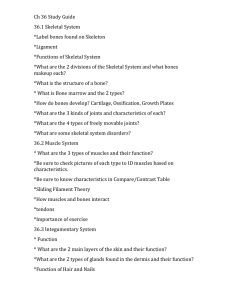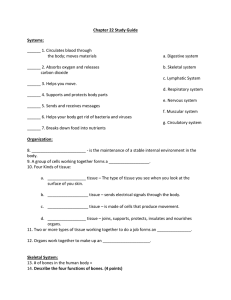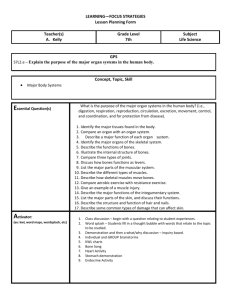Chapter 22
advertisement

Chapter 22 Introduction to Body Systems Skeletal, Muscular, and Integumentary Systems Section 1: Objectives • • • Describe how tissues, organs, and organ systems are related. List 12 organ systems. Identify how organ systems work together to maintain homeostasis. Introduction to Organ Systems • The many kinds of cells in your body help your internal environment stay stable. • The maintenance of a constant internal state in a changing environment is called homeostasis. Introduction to Organ Systems A group of similar cells working together forms a tissue. Your body has four main kinds of tissue. Introduction to Organ Systems Two or more tissues working together to carry out a specialized function form an organ. Introduction to Organ Systems • Organs that work together make up an organ system. • Organ systems work together to maintain homeostasis. • Your body has 12 major organ systems. Introduction to Organ Systems Section 2: Objectives • Identify the major organs of the skeletal system. • Describe four functions of bones. • Describe three types of joints. • List three injuries and two diseases that affect bones and joints. The Skeletal System • Bones, cartilage, and the connective tissue that holds bones together make up your skeletal system. • Bone tissue without any visible open spaces is called compact bone. • Bone tissue that has many open spaces is called spongy bone. • Bones contain a soft tissue called marrow. • Most bones start out as a flexible tissue called cartilage. • Eventually, most cartilage is replaced by bone. The Skeletal System The Skeletal System • • A place where two or more bones meet is called a joint. Joints are held together by ligaments. The Skeletal System • • Bones may be fractured or broken. Ligaments can be stretched or torn. • Arthritis is a disease that causes the joints to swell or stiffen. • Osteoporosis is a disease that causes bones to become less dense. Chapter 22 Sec. 1-2 Recap 1) List 1 way the different types of cells in your body work together. 2) T/F Your body has 1 type of tissue. 3) List the 3 parts of the skeletal system. 4) What is cartliage? 5) What is the function of ligaments? 6) T/F Ligaments can be stretched but not torn. 7) Bones can be broken or fractured. Section 3: Objectives • List three kinds of muscle tissue. • Describe how skeletal muscles move bones. • Compare aerobic exercise with resistance exercise. • Describe two muscular system injuries. The Muscular System • The muscular system is made up of the muscles that let you move. • Involuntary muscle found in the digestive tract and the walls of the blood vessels is called smooth muscle. • Involuntary muscle found in your heart is called cardiac muscle. • Muscle attached to your skeleton for movement is called skeletal muscle. • Skeletal muscle can be voluntary or involuntary. The Muscular System Tendons are strands of tough connective tissue that connect your skeletal muscles to your bones. Skeletal muscles often work in pairs. A muscles that bends part of your body is called a flexor. A muscle that straightens part of your body is an extensor. The Muscular System The Muscular System During resistance exercise, people work against the resistance, or weight, of an object to strengthen their skeletal muscles. Steady, moderately intense activity is called aerobic exercise, and strengthens the heart and increases endurance. The Muscular System • A strain is an injury in which a muscle or tendon is overstretched or torn. • People who exercise too much can hurt their tendons. Inflamed tendons is called tendonitis. • Some people try to make their muscles stronger by taking drugs. These drugs are called anabolic steroids and can cause longterm health problems. Section 4: Objectives • • List four functions of skin. Describe the two layers of skin. • Describe the structure and function of hair and nails. • Describe two kinds of damage that can affect skin. The Integumentary System • Your skin, hair, and nails make up your integumentary system. • Skin protects you by keeping water in your body and foreign particles out of your body. • Nerve endings in your skin let you feel things around you. • Skin helps regulate your body temperature and also helps get rid of waste chemicals. The Integumentary System • The epidermis is the outermost layer of skin. • Most cells in the epidermis are dead. • The thicker layer of skin that lies beneath the epidermis is the dermis. The Integumentary System The Integumentary System • A hair forms at the bottom of a tiny sac called a hair follicle. • Hair helps protect skin from ultraviolet light and helps regulate body temperature in most mammals. • A nail grows from living cells in the nail root at the base of the nail. • Nails protect the tips of your fingers and toes. The Integumentary System Skin is often damaged, but fortunately can repair itself. However, damage to the genetic material in skin cells can cause skin cancer.





